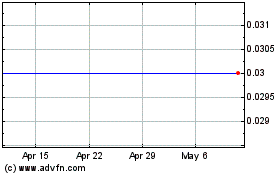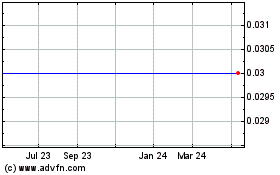Pancontinental Uranium Corporation (TSX VENTURE: PUC) ("Pancon") is
pleased to report that its joint venture partner, Crossland Uranium
Mines Ltd, (ASX: CUX) ("Crossland") has identified extensive
alluvial deposits that host heavy minerals containing rare earth
elements (REE) at the joint venture's Charley Creek Project area in
Northern Territory, Australia. These REE deposits are separate from
Crossland's uranium prospects, which remain the Joint Venture's
primary focus at Charley Creek and elsewhere.
HIGHLIGHTS
-- A heavy mineral concentrate produced by Crossland from a sample of
stream channel alluvium has returned high values for REE, (39% total
rare earth oxide), with particularly high proportions of the heavy REE,
including Gadolinium (Gd), Terbium (Tb), and Dysprosium (Dy). These are
present in phosphate minerals that should be readily processed using
available REE extraction technology.
-- Crossland believes that these REE ratios are typical of those throughout
the Cockroach Dam Prospect, within the Charley Creek Project, and that
they will extend over a broader area both in bedrock and alluvium
derived from these bedrocks. A substantial tonnage potential for REE-
bearing alluvium in various settings is evident from exploration
techniques already developed and applied in the area.
-- The target types are found on surface and near-surface, and are loosely
consolidated deposits that should be amenable to relatively low cost
exploration and mining methods.
-- An initial development objective for stand-alone development would be
production of a saleable REE-rich heavy mineral concentrate at a rate of
several thousand tonnes per annum. The permitting and capital costs of
such an operation should be relatively low.
BACKGROUND
During follow-up of Crossland's detailed ground spectrometer
surveys of the Cockroach Dam uranium prospect (NT) in the Teapot
Granite during 2009, geologists identified rock samples returning
elevated levels of rare earth elements (REE). These rocks
outcropped in areas with their own characteristic radiometric
pattern, generally unrelated to the uranium anomalies, which remain
the Crossland/Pancon Joint Venture's primary focus in the Charley
Creek Project.
Subsequent follow-up of areas with similar radiometric patterns
established that there were widespread areas with elevated rare
earth values. Sampling of rock outcrops revealed that the REE suite
contained unusually high proportions of the heavy rare earth
elements, particularly Dysprosium and Terbium, which are reported
to be in short supply globally. Furthermore, there were extensive
eluvial and alluvial sediments developed from direct weathering of
these REE-enriched rocks, and these in places appeared to have
significantly upgraded content of the heavy minerals that contain
the REE. Therefore, it appears there is potential to examine
development of a relatively low capital cost route to production of
a marketable REE heavy mineral concentrate from near-surface
deposits.
Crossland has sought expert guidance on the likelihood that this
type of occurrence had commercial possibilities, and the expert
confirmed the possibility for a development target based around
alluvial deposits of heavy minerals enriched in heavy REE. He
recommended that the first step in the evaluation of the prospects
was to investigate if heavy mineral concentrates could be produced
using simple physical separation methods based around the specific
gravity of the REE bearing minerals. Several kilograms of pan
concentrate was produced in the field and submitted to the
laboratory for heavy liquid separation, as the first step in this
appraisal.
While this sample relates to stream sediment collected from one
drainage, Crossland's reconnaissance rock sample results leads us
to expect that the REE mix reflected here should be typical of
those from other drainages so far sampled in the Cockroach Dam
Prospect.
RESULTS
The initial analysis of this material has now been received (see
table below). In reporting these results, Crossland cautions that
analyses have been performed by the accredited laboratory, ALS
Global, using their method ME-MS81h, a lithium borate fusion/nitric
acid digest method specifically developed for analysis of high
contents of REE. However, the analyses exceed the upper level of
detection for six of the REE: Ce, Gd, La, Nd, Pr, and Sm, so for
these elements the analyses need to be repeated by an even less
sensitive method to obtain absolute values. Electron microprobe
work undertaken by Crossland has confirmed that the REE bearing
phase is a phosphate mineral, which should result in good
recoveries with currently standard REE extraction technology.
Initial comparisons with other published information on REE
distribution in potential and operating deposits suggests that the
Cockroach Dam distributions are particularly elevated in
Gadolinium, Terbium, and Dysprosium, and additionally the rarer
heavy REE, such as Holmium, Erbium, Thulium, Ytterbium, Lutetium,
and Hafnium, which together total almost 1% of the Rare Earth Oxide
(REO) mix.
INTERPRETATION
Crossland believes that these results are sufficient to justify
implementation of a supplementary exploration program to appraise
the extensive areas of alluvium that exhibit the characteristic
radiometric response that has led us to these results in the
Cockroach Dam Prospect area. This work would be separate from
uranium exploration efforts, which are on nearby, but separate
areas. Because of the shallow and widespread nature of the
potential alluvial REE resource, it will be possible to evaluate
the REE potential quickly and relatively cheaply.
There are four distinct alluvial settings within Crossland and
Pancon's Charley Creek Project areas that may host viable REE heavy
mineral occurrences.
These are:
1. Active streams draining immediately from areas of bedrock containing
elevated values of REE
2. Residual fossil drainage systems and eluvial deposits in areas of
shallow REE- enriched bedrock
3. Broad alluvial flats associated with the more prominent streams in the
Cockroach Dam/Teapot drainages
4. Large alluvial outwash fans that are sourced in the Cockroach Dam/Teapot
Granite Hills, and spread across the alluvial flats to the north of the
MacDonnell Ranges.
These sources probably have decreasing alluvial grade potential,
but increasing tonnage potential, in the order listed. Crossland
and Pancon would initially target an alluvial resource capable of
relatively rapid and low-cost exploration, permitting, and
development, to produce several thousand tonnes of heavy mineral
concentrate per annum in a stand-alone operation. If Crossland and
Pancon succeed in establishing a viable uranium resource on
adjacent uranium anomalies currently being drilled, then the
possibilities for an on-site processing plant would be
enhanced.
Crossland intends to propose to develop the REE sampling program
as a program to engage local Aboriginal youths in working with us
in the exploration industry.
TABLE: Analytical results of TBE sink fraction, by method
ME-MS81h (ALS Global)
----------------------------------------------------------------------------
----------------------------------------------------------------------------
Element Oxide wt% of total sample weight % of Total REO
----------------------------------------------------------------------------
CeO2 18.423 47.15%
Dy2O3 0.357 0.91%
Er2O3 0.124 0.32%
Eu2O3 0.029 0.07%
Gd2O3 0.622 1.59%
HfO2 0.069 0.18%
Ho2O3 0.054 0.14%
La2O3 8.761 22.42%
Lu2O3 0.013 0.03%
Nd2O3 5.879 15.05%
Pr2O3 1.703 4.36%
Sm2O3 0.901 2.31%
Tb2O3 0.080 0.20%
Tm2O3 0.017 0.04%
Y2O3 1.943 4.97%
Yb2O3 0.099 0.25%
TOTALS 39.073 100.00%
----------------------------------------------------------------------------
----------------------------------------------------------------------------
All technical information in this release has been reviewed by
Geoff Eupene, Qualified Person for Crossland and Pancon.
About Pancontinental Uranium Corporation
Pancontinental Uranium Corporation ("Pancon") is a
Canadian-based company focused on uranium discovery and
development. Through a 50:50 joint venture with Crossland Uranium
Mines Limited ("Crossland") of Australia, Pancon has established
one of the strongest management teams in the uranium industry. This
management and operating team has unparalleled experience from
exploration, through development to operations, and includes people
who were instrumental in the discovery of two of the largest
uranium deposits in the world. Pancon and Crossland hold an
impressive uranium exploration portfolio with projects in prolific,
mining friendly districts.
Active exploration is ongoing at three Australian projects which
include Chilling, Charley Creek, and Kalabity. The Chilling project
has the potential to host a mirror image of a portion of the
renowned Alligator Rivers Uranium Field containing the large
Jabiluka, Ranger and Koongarra deposits. Charley Creek has the
potential for large, lower-grade, Rossing-type, granite hosted
uranium deposits. The Kalabity project lies in a district of
historic uranium/radium mining that contains a variety of known
uranium deposit styles.
Pancon has earned a 50% interest in this significant uranium
project portfolio through the joint venture with Crossland through
the expenditure of A$8 million. Pancon and Crossland are also
pursuing exploration beyond Australia through an international
subsidiary company, Crosscontinental Uranium Limited, and immediate
plans include formulating an exploration program in Burkina
Faso.
ON BEHALF OF THE BOARD OF DIRECTORS
Rick Mark, President & CEO
Cautionary Language and Forward Looking Statements
This press release may contain "forward-looking statements",
which are subject to various risks and uncertainties that could
cause actual results and future events to differ materially from
those expressed or implied by such statements. Investors are
cautioned that such statements are not guarantees of future
performance and results. Risks and uncertainties about the
Company's business are more fully discussed in the Company's
disclosure documents filed from time to time with the Canadian
securities authorities.
Neither TSX Venture Exchange nor its Regulation Services
Provider (as that term is defined in the policies of the TSX
Venture Exchange) accepts responsibility for the adequacy or
accuracy of this release.
Contacts: Pancontinental Uranium Corporation Richard Mark
President and CEO 604-986-2020 or 1-866-816-0118 Pancontinental
Uranium Corporation Keith Patey Director of Communications
604-986-2020 or 1-866-816-0118 www.PanconU.com
Pancontinental Resources (TSXV:PUC)
Historical Stock Chart
From Dec 2024 to Jan 2025

Pancontinental Resources (TSXV:PUC)
Historical Stock Chart
From Jan 2024 to Jan 2025
